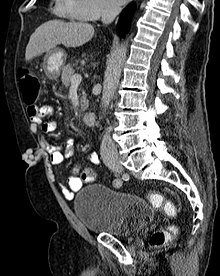Caput medusae
| Classification according to ICD-10 | |
|---|---|
| I86.8 | Varices of other specified locations |
| ICD-10 online (WHO version 2019) | |
A caput medusae ( Latin for head of Medusa ) is a clinical sign that manifests itself in the form of a visible expansion of tortuous veins ( venae paraumbilicales ) in the area of the navel as a result of blood congestion caused by portal hypertension .
root cause
A pathologically caused congestion in the portal vein circulation of the liver (mostly due to liver cirrhosis ) leads to enlargement of the portocaval anastomoses , which supply the blood in a bypass circuit to the inferior vena cava ( vena cava inferior ) and thus to the heart . The paraumbilical veins located under the abdominal wall in the area of the navel are expanded by the increased load and become visible under the skin.
Caput medusae in glaucoma
The term Caput Medusae also describes an episcleral (loose layer of connective tissue on the dermis of the eye ) enlargement of the vessels in acute glaucoma . With this eye disease, the intraocular pressure is temporarily or permanently increased.
term
The term has its origin in Greek mythology . The Medusa contributed to its transformation by Athena snakes on her head, a portrait that described finding is similar.
literature
- Gerd Herold : Internal Medicine. A lecture-oriented presentation. Taking into account the subject catalog for the medical examination. With ICD-10 key in the text and index. Herold, Cologne 2005.
